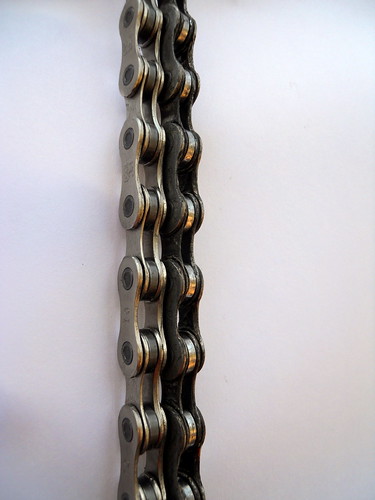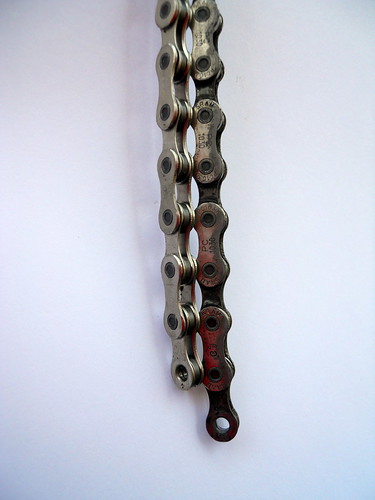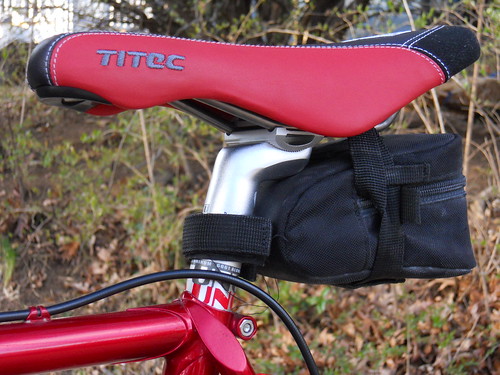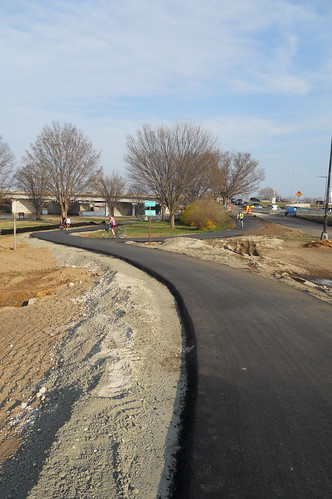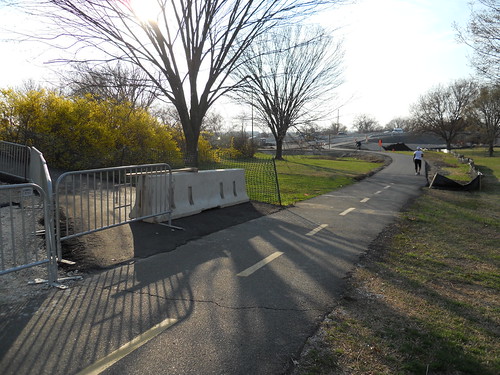
On the bike trail along Four Mile Run, Arlington VA
I don't really understand why he isn't hot in there, although I suppose some air circulates from below and it is somewhat open in front of him to let hot air out.
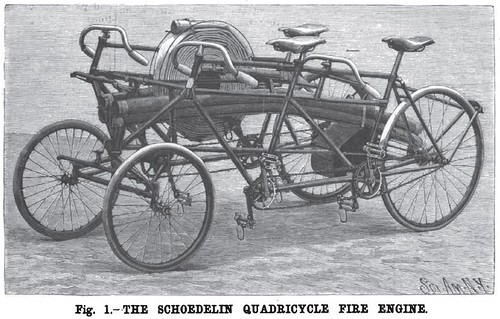
A QUADRICYCLE FIRE ENGINEAn interesting notion - I don't believe this caught on in the U.S. In a radius of travel less than a couple of miles and with relatively flat terrain, this could make sense, but notwithstanding the advantages of quick response cited, one can imagine fire fighting personnel would prefer not to pedal to fires.
We illustrate herewith a quadricycle fire engine that attracted considerable attention at the recent bicycle exhibition at Paris, and which presents unquestionable advantages over the hand engines in use in all places that are too small to afford the luxury of steam fire apparatus.
As shown by our engravings (Figs. 1 and 2), the engine consists of two tandem bicycles coupled by crosspieces in front and behind and having but a single steering post in front. The free space between the two frames is occupied at the front by a hose reel, in the center by a rotary pump, and at the back by a coupling that allows the pump to be put in communication with a water tap.
This entire affair weighs scarcely more than 180 or 188 pounds, which represents about 88 pounds per man. [This per man figure does not seem right, whether the riders' weight is factored in or not, but is what is stated in the original.] It will be seen that upon such a machine four trained cyclists can reach a fire at a speed that could never be attained by fire engines drawn by horses.
Figure 2 - Ready for Operations
As soon as the engine has reached a favorable position, the four men jump from their seats, and, while two of them adjust the couplings, a third unreels the hose, and the fourth, turning down the jointed support, raises the back of the machine and throws the pump into gear.
The four men afterward get into their saddles and pedal in situ with a mean velocity that causes the pump to discharge about 4,500 gallons an hour in the form of a stream 100 feet in length in a horizontal direction and about 75 feet upwardly. These figures are those obtained at the trials made at the Palace of Industry on the 23d of last December.
All the preparatory maneuvers require scarcely more than two or three minutes. If, on another hand, we take into consideration the fact that such machines, propelled by men with some little training, can reach a fire in a quarter or a third of the time made by ordinary hand engines, we shall realize how great an interest attaches to the use of them in country places where a fire so easily assumes the importance of a disaster by reason of the tardiness with which the first help comes. Everything, therefore, leads to the belief that this invention is destined to completely revolutionize the fire apparatus of small towns and villages.
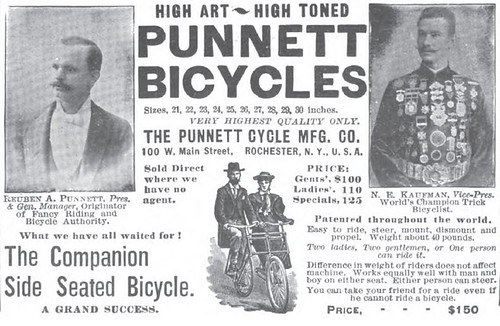
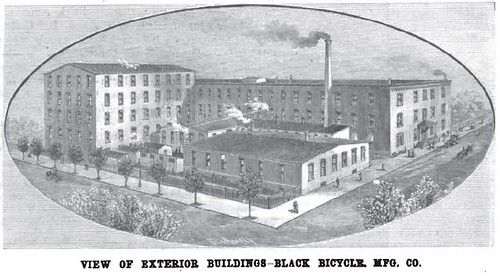
THE TRIBUNE BICYCLEWhat I have done here is bring together the illustrations that were on the cover of the issue and with the article with my hand-corrected version of the OCR'ed text, but some errors likely remain (alas) - if you come across a mistake, let me know in the comments and I'll fix. Thanks!!
Within the past three years, the American bicycle Industry has grown up to dimensions which fairly entitle it to be considered representative of the country and of the day. Every day sees hundreds of wheels of high and low grade made in the factories of this country for the American and foreign market. Three years ago the English bicycle was considered by many the best wheel, and the possessor of such was apt to consider himself better equipped than his friend who rode one of American manufacture. Now, all is changed. A visitor to England or to the Continent, if a cycling enthusiast, cannot fail to be impressed by the superiority of American wheels as contrasted with the foreign ones, and no wheelman really an fait in his subject would dream of buying his wheel abroad, so superior is the American make. The industry has brought about an enormous development in the manufacture of special tools and of parts of bicycles.
Assembling the Bicycles
Many assumed bicycle manufacturers simply buy these parts and do their own assembling. But for the production of the absolutely high grade American bicycle, a factory is required which will turn out practically all the parts of the wheel manufactured, for unless such is done one concern cannot be answerable for the perfection of the whole machine.
We select as the representative of such a factory the works of the Black Manufacturing Company, of Erie, Pa., a company which produce the highest grade of wheel and which put it on the market purely on its merits without the adventitious advertisement of paid riders. The wheel made by this company, the "Tribune Bicycle," embodies the best possible practice and is correspondingly free from structural variations of unproved merit.
Milling Machine
The tubing, whose walls are of 20 gage thickness, is of American make, the company having found that English tubing could not be obtained of sufficiently even quality. At the junctions of the tubes forged connections are employed. These are received in a solid state and are machined out, drilled and turned, until only a shell of the original material is left. Each connection has projecting nipples which enter the ends of the tubes, and the whole is so accurately made that when the ends of the tubes are placed over the nipples the frame will hold itself together without further fastening. The tubes are of uniform diameter throughout and are simply cut of proper length, so that their natural strength is unaffected. The most striking instance of the preparation of the forged connections is in the crank bracket. This is received as a massive forging weighing 3 pounds 2 1/2 ounces, in general shape a cylinder, with four solid projections. This is put into the finishing machine and finished. It comes out with the solid cylinder drilled out so as to present a large aperture through which the crank shaft is to go. and its ends faced off and finished for the reception of the ball races: The four projecting nipples are drilled out and are also turned down on the outside so as to fit accurately the outside of the tubing. The bracket now weighs 8 ounces; all the rest has been converted into drill chips. One of the typical connections is that used for the head of the rear forks, which forging we specially illustrate, in order to show how solid a construction is given to this vital point.
Rear Fork
The frame has now to he brazed together. The pieces are placed in a massive iron jig or template, adapted to receive them and retain them in position, and which holds horizontally the entire frame. This template is mathematically accurate. While held therein, holes are drilled through the connections and tube ends and pins are driven in, pinning all the parts together. When removed from the jig the frame is perfectly rigid. It now goes to the braziers, who, with the best quality of brass and with large gas blowpipes, braze all the the liquid spelter penetrating all the join even running out around the pins. The frame next goes to the filers, after the borax has been brushed off it, who with file and emery paper, go over all the connections and over the tubing, polishing it all, and removing every excrescence, which, it will be observed, gives the frame an absolute hand finish over all its surface.
Brazing Room
The forks taper toward the end, and to produce this taper cold swedging is employed. The swedging machine carries a heavy head like a lathe head or chuck, which rotates in a horizontal axis, and within which are eight hammers, which by the action of the machine move in and out in radial directions. A piece of cold tubing pushed into the machine and fed up by hand is subjected to a multiplicity of blows and has its diameter rapidly reduced, the workman being able to give it any desired taper. The metal thus tapered is flattened and bent to the proper curve to give one side of the fork.
Cold Swaging Machine
[For someone who doesn't know what "swaging" is - like me - you can read something about it in Wikipedia.]
The cups and cones for the ball bearings are made on automatic turret lathes, the turret carrying in some cases as many as five tools. A bar of tool steel which may be 20 feet long is introduced into the machine and is gradually and automatically fed up to the tools, which shape and cut off from it bearing after bearing, which drop from it every few seconds without any attention from the workman. A liberal supply of oil is kept in constant circulation through the machine, falling upon the cutting tools. The bearings thus finished are purposely left 0 005 of an inch too large. They are then screwed on a mandrel in a special lathe and the final finish is given by hand. They are then tempered by secret process with sperm oil and polished, coming out with a beautiful straw color, equal in finish to any steel tools made. The standard finish of the machine is black enamel and nickel plate. The enamel is put on in four coats, two of India rubber enamel and two polishing coats, the frame being rubbed down with rottenstone between the applications. This gives a finish equal to a piano body. To secure evenness the enamel is applied by dipping in a tank of the compound, after which the parts are hung up and allowed to drip to remove the surplus before baking. All nickel plated parts are first copper plated. This prevents water or moisture from getting under the nickel and rusting the steel and thereby causing a separation of the coating.
[Factory Floor]
The aim of the constructor of this typical American wheel has been to secure simplicity and produce an absolutely standard article. Its criterion is its quality pure and simple. There are, however, some novelties introduced that are especially worthy of illustration. One of these affects the crank and crank shaft mechanism, the crank being secured to the shaft in a new way. V-shaped teeth are formed upon the crank shaft and upon the aperture in the pedal arm. This aperture in the pedal arm is split and provided with a tightening screw. To attach the ciank arm to the shaft, it is thrust over the end of the shaft and the tightening screw is turned up, when it is secured as rigidly as if all were one piece of metal. Those who have struggled with the old-fashioned cotter will realize the advantage of this crank, which is instantly released with two or three turns of a screw.
The handle bar is made adjustable by an arrangement of equal simplicity and efficiency. The socket in the head which receives it is threaded. On the center of the handle bar is brazed a sleeve threaded with the same pitch of screw. The socket is split and provided with a tightening screw. The screw is loosened, the handle bar thrust through the socket and screwed into place. When at the desired angle the screw is tightened and the whole becomes practically one piece of metal. By reversing the handle bars, they can be used in up-tumed or downturned position.
The sprocket wheels ought not to be spoken of as a novelty now. They are cut to the cycloidal or theoretically correct curve, which avoids all friction of the chain against the teeth. This has long been the specialty of the Black Manufacturing Company, but now the system has spread among other companies, and cycloidal sprockets are characteristic of several other first-class wheels.
Cycloidal Sprocket
We also illustrate the system of truing up the wheel. Each wheel is mounted on a gaging frame, and the workman, by setting up and loosening the nipples, brings the rim into an absolutely perfect plane. The steering arrangement of the tandem machine deserves attention. Sprockets are carried by the front and rear steering posts, and these sprockets are connected by chains and rods so as to insure unity of steering action between the front and rear handle bars.
Wheel bearings
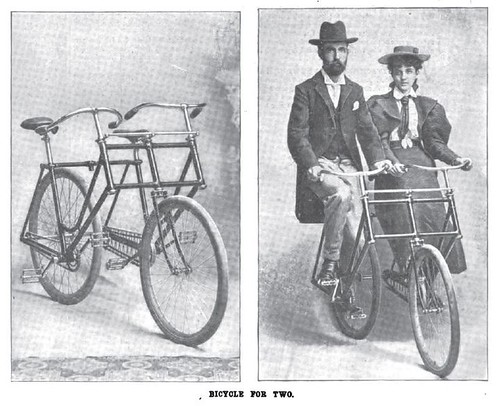
THE PUNNETT COMPANION SIDE SEATED BICYCLE.I can't work out if this really could work or not - apparently it did, but it seems difficult to manage, to say the least.
The bicycle has now reached a typical construction from which there seems to be slight tendency to deviate. Absolute novelties beyond the details are more and more rare. The companion side seated bicycle which we represent is. however, one of the novelties of the year. The tandem bicycle, which has met with considerable success where the desire is to have company on a ride, is more or less criticised on account of the position of the riders, one of whom must be behind the other. In the bicycle which we illustrate it is proposed to have the two riders seated side by side, as in the old-fashioned "sociable" tricycle, and yet to have the two riders carried by two wheels only. The two cuts are self-explanatory. The long axle of the rear wheal enables the use of two sprockets at its extremities so far apart as to permit of each one being acted upon through a separate pair of sprockets, each actuated by a separate rider. There is a triple head and a duplex frame, the latter carrying two saddles placed side by side at a proper distance apart for two riders to occupy also side by side.
It is said that a difference of 100 pounds weight in the two riders is not noticeable, and that a person who is ignorant of riding can be taken out on this wheel with perfect safety. The system of mounting is peculiar. For the first one who mounts, the wheel is inclined to one side and this rider takes his or her place on the lower saddle. The machine is then pulled back to an upright position and the second rider mounts by the pedal, and so the start is made. The dismount is made in the same way, reversing, of course, the operations. The two saddle posts are connected, it will be observed, by a crossbar. At the center of the crossbar is a special socket. When a single person fa riding the wheel the saddle is transferred to the central position and the rider sitting there drives the machine by one of the right hand and one of the left hand set of pedals. This, of coruse, produces considerable lost motion in the pedal action, but it at least is possible for a single rider to take care of and to drive the wheel to and from the place of appointment with his friend. It is not a wheel depending absolutely on the presence of two riders. The wheel shown in the illustrations is made by the Punnett Cycle Mfg. Co., Rochester, N.Y.
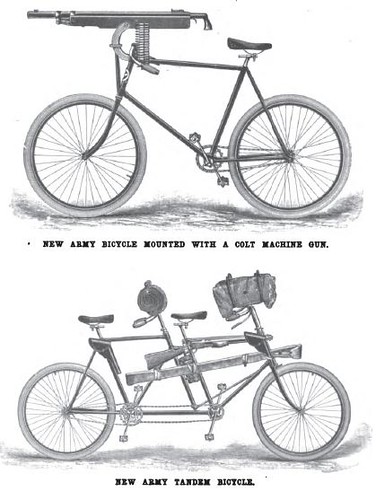
NEW ARMY BICYCLESFor good or bad, cycles as a part of warfare didn't catch on. Original article is here.
The new army tandem and the model 40, mounted with a Colt's automatic machine gun which have been made by the Pope Manufacturing Company, were exhibited at the Madison Square Garden Cycle Show and attracted great attention.
The tandem is one of the Pope Company's regular model 43s taken directly from stock and finished plainly in enamel and nickel. On the front handle bars are tightly strapped two army overcoats, and on the rear bars a pair of blankets. Resting safely in brackets on either side of the machine is a twelve shot repeating rifle, and hanging on each seat post a Colt quick action revolver of the latest pattern. In addition to this there is a case of signal flags extending almost the whole length of the machine, but not interfering with the riders in the least; and this is the case with all the equipments, being as well and safely placed, ready for use in a moment, and yet causing not the slightest interference.
The Colt automatic gun mounted on the model 40 is the one recently adopted by the government for our navy. This gun weighs between thirty-nine and forty pounds, shoots two hundred and fifty or five hundred times—being automatically fed—and is remarkably accurate. It is fastened securely to the head of the machine, can be easily directed at any angle, and does not interfere with the rider or affect the steering of the machine.
These two wheels are as perfectly equipped with the necessary accouterments of war as would seem possible, and the interest which army people and civilians alike have shown in them leads one to believe that it will not be long before the wheel will form a very effective adjunct to regular army service.
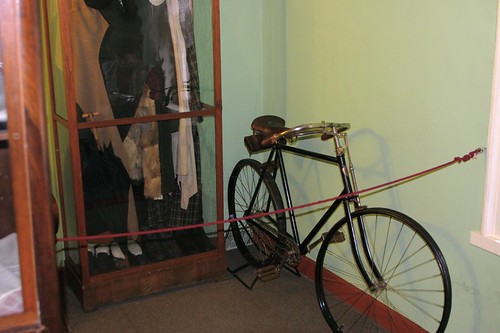
Count Leo Tolstoi, the Russian novelist, now rides the wheel, much to the astonishment of the peasants on his estate.Apparently Tolstoy took up bicycling at the age of 67. Russia comes up again in a later Cycling Notes entry, for May 9, 1896:
Though Moscow has nearly five thousand wheelmen, only about one-half have permission to ride in the city limits. [?!?!?] Russia asks $12.50 duty on each wheel imported into that country, no matter what the price may be.Presumably Tolstoy had no problem paying a price that included this fairly high duty.
When the spirits are low, when the day appears dark, when work becomes monotonous, when hope hardly seems worth having, just mount a bicycle and go out for a spin down the road, without thought on anything but the ride you are taking.But did he have more to say? Yes he did.
I have myself ridden the bicycle most during my practice as a physician and during my work in letters. In the morning or the afternoon, before or after work as the mood o'ertakes me, I mount the wheel and am off for a spin of a few miles up or down the road from my country place. I can only speak words of praise for the bicycle, for I believe that its use is commonly beneficial and not at all detrimental to health, except in the matter of beginners who overdo it.This quote from the physician Conan Doyle was in the spirit of this period to find medical doctors who would endorse the health benefits of cycling, or at least not condemn it. That he was a famous and clever writer was presumably a bonus.
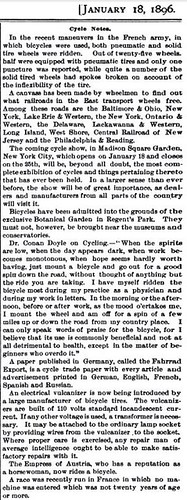

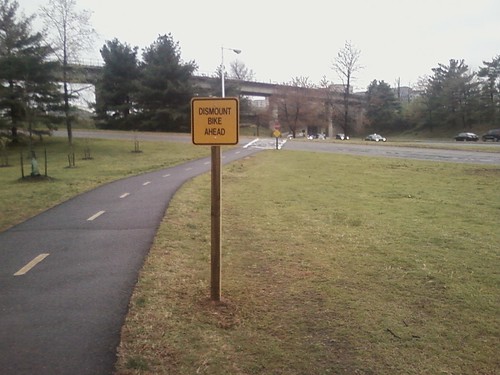

The authors of the program are betting on cycling. "They move through the city with an average speed of 17 kilometers an hour and get around all traffic jams, while the average speed of cars reaches only 25 kilometers per hour and in rush hour doesn't exceed 13 km/hr" - they claim as advantages of bicycles. A driver pays an average of five rubles per kilometer [28 rubles to the dollar] and the government pays roughly the same amount in addition as expenses for supporting the infrastructure, so the authors of the program consider that cycling support would have savings for the citizens directly and for the government. They suggest constructing by 2016 no less than 150 km of bike paths and bike lanes and to create 10,000 bike parking places in Moscow.



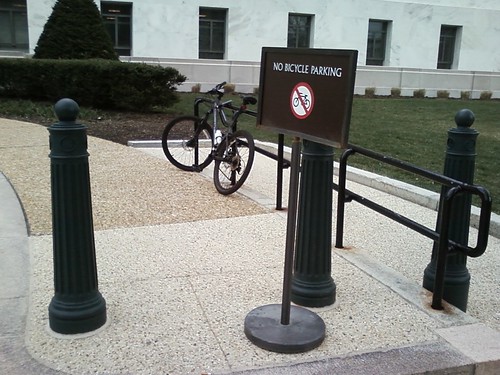
Another novelty is the duplex wheel [that is, bicycle - with side-by-side seating], with the Maxim rapid-firing gun mounted upon it. It carries two riders, one to propel the machine and the other to work the gun. It is understood that a proposition has been made to the representatives of the Cuban government to equip a regiment of their soldiers with these machines, it being shown that with proper handling they would prove awful and effective engines of destruction.Unfortunately no illustration of this bicycle was included and I have had no luck finding one elsewhere. The machine-gun equipped bike didn't seem to prosper as a tool of war.
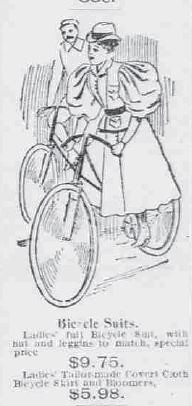
THE WOMAN CYCLIST.And finally this ~
She Reigns Supreme This Season. Some Timely Suggestions for Her.
The woman cyclist reigns this season. The number of women who have taken to the wheel shows an increase of 75 percent, and the makers of machines for women can scarcely keep pace with their orders.
In the selection of a machine most women who are making their debut as riders this reason need reliable wholesome advice, and if any points of value are secured from this article its purpose will have been fulfilled.
So far as the costume is concerned, knickers are very largely worn in Europe, especially in Paris, but in America they are the exception more than the rule, and therefore this is addressed to ladies who will ride in skirts.
The question of weight in connection with ladies' machines has recently received more attention at the hands of manufacturers than ever before, and the consequence is reliable machines may now be purchased, fitted with brake, mud guards, dress-guard, and gear-case at just about thirty pounds in weight.
In selecting a machine a lady should see that the handle bars and saddle can be so adjusted as to enable her to sit perfectly upright, for nothing looks much worse than to see a lady adopting what is known as the "scorcher" attitude.
Large makers build machines in more than one size, and exceptionally short and exceptionally tall ladies should have machines built higher and lower respectively in the frames than standard patterns.
The pedals should be rubber, and not all steel, the latter with their sharp points being more liable to catch in the rider's dress, pedals to suit the width of foot, can, of course, be selected.
A really first class-machine by a leading firm will cost nearly $lOO, or perhaps a little more, but, of course, very good machines can be purchased for less than that amount.
There are several little things a tider should be particularly careful about, and one of these is the application of the brake. The brakes fitted are usually those which act on the tire, and should consequently not be too suddenly applied, or they will probably tear the tire.
A lady will find it very convenient to mount from the curb, and will thus be enabled to properly arrange her dress. Sometimes this method of mounting is impossible. A lady will then do well to allow one of the pedals to ascend to its fullest height and descend the merest trifle, and then, placing one foot on the pedal in question, spring into the saddle, the weight of her body on the pedal necessarily causing the machine to go forward. When well going it will only be necessary to slightly raise herself in the saddle, actually standing on the pedals, and the dress will fall as it should. This will be found to be a perfectly easy accomplishment with a little practice.Full article as PDF is here.

To establish a bicycle track from coast to coast so that wheelmen can journey from New York to San Francisco as easily if not as rapidly as they now do by train. Such tours have been undertaken and partlv carried out. One man would wheel from Salt Lake Cit to Buffalo. Another, at some time, would start at Chicago and wheel to the Pacific Coast. But they seldom wanted to take the trip twice. It was too tiresome. Roads were too bad. Too many mountain paths had to be climbed, too many prairies tortured through. But I am looking into the matter so as to do away with all this.
What has hampered us more than anything in this cross country project are the wheeling [cycling] enthusiasts. These gentlemen insist upon bicycle paths and so we get nothing. A macadamized bicycle path costs in a rocky locality $15,000 per mile. Now make this same locality and use tho road that is already in it by merely improving it and the cost will not be $3,000. You can make a mile or very bad road into very good road for that sum. That is what I mean by intelligent wheeling legislation.
"Across the country in eighty days will be the wheelman's attraction a few years hence. Now it looks funny, but that is what Jules Verne's idea or "Round the World In Eighty Days" did to people years ago. Now we can belt the sphere in seventy days."Full text of article available most readably here.
